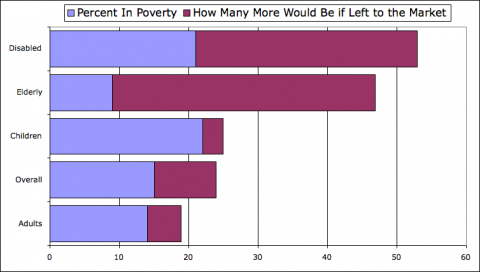Matt Bruenig gives us a great breakdown of what poverty would look like if we relied on the market to solve it (as we did almost exclusively for thousands of years before the emergence of enlightened modern welfare states over the last two centuries).
The poverty rate among the elderly would be > 45%. (Old folks with long memories: sound familiar?)
Thanks to Social Security, Medicare, etc., it’s 9%.
Here are Matt’s numbers in graphical form for easy digestion:
Read the whole thing.
Cross-posted at Angry Bear.

Comments
One response to “How We Reduce Poverty, and How “The Market” Doesn’t”
The problem with this analysis is that Social Security is being classified as welfare. It is not, it is designed to be a government run substitute for market based pension and insurance schemes (what you get out is a function of what you get in). Supplemental Social Security (SSI) on the other hand can be classified as welfare, your benefits are a function of need, not contributions.
These distinctions are important when making comparisons between countries. For example, one reason that Australia’s spending as a percent of GDP is so low is that it has a privatized Social Security scheme – payments are not part of government spending. Being a fan of Lane Kenworthy, you are probably also aware of the net benefit issue.